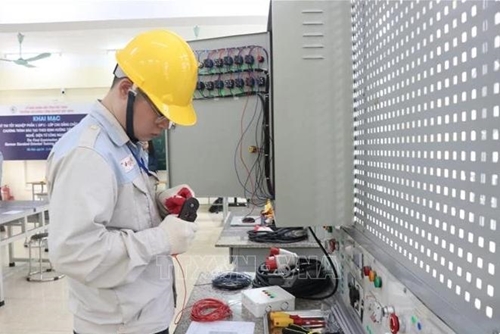The country's high-tech manufacturing expansion is creating a knock-on effect on the industrial property sector, with a prime example being the recent investment from U.S. tech giant NVIDIA in an R&D center in Vietnam. Minister of Planning and Investment Nguyen Chi Dung described this as a "historic milestone," positioning Vietnam to become Asia's premier AI research and development hub.
Statistics from the Ministry of Planning and Investment’s Foreign Investment Agency showed that Vietnam’s total registered FDI reached nearly 38.23 billion USD in 2024, including major projects in high-value-added sectors like semiconductors, energy, and electronic manufacturing getting new investments and capital expansion.
    |
 |
|
Vietnam is targeting to have 50,000 skilled workers for the semiconductor industry by 2030. |
Thomas Rooney, Associate Director of Industrial Services at Savills Hanoi, emphasizes Vietnam's strategic advantage as a destination for major tech corporations, citing its favorable position in global supply chains. The wave of investments into high-tech projects and the R&D center boosts demand for infrastructure and ready-built factories as well as opens up potential growth for the industrial real estate market.
According to Savills Industrial Insider Report 2024, the national industrial land area exceeds 38.200 hectares across 203 operational industrial zones, reflecting a 5% increase year-on-year.
Vietnam benefits from its proximity to the Silicon Valley of China (Guangzhou-Shenzhen-Dongguan), making it a prime location for supply chain diversification strategies. This helps major companies reduce dependency on China (the China Plus One strategy) and mitigate geopolitical risks, the expert said.
The country's robust infrastructure development continues to enhance its appeal to foreign investors. With 7% of GDP allocated to crucial projects such as the North-South expressway, Long Thanh International Airport, and deep-water ports like Cai Mep in Ba Ria - Vung Tau, Vietnam is strengthening its direct connections to Europe, the Americas, and Southeast Asia.
Moreover, the country’s abundant workforce, policies supporting high-tech projects, and ongoing infrastructure improvements make Vietnam an attractive destination for international investors, positioning it as a high-tech manufacturing hub.
The recent cooperation agreement between the Vietnamese Government and NVIDIA, a world leader in AI and semiconductors, marks a significant milestone and presents an opportunity for the country to become Asia’s leading AI R&D center. NVIDIA’s establishment of an R&D center in Vietnam, coupled with the Government’s human resources development strategy and support policies, promises to deliver higher added value, attract investment, and foster cutting-edge tech sectors, Rooney analyzed.
“NVIDIA's establishment of an R&D center in Vietnam will stimulate demand for the development of high-tech zones, increase the value of industrial real estate and attract further capital from major tech investors. This will elevate industrial zones and expand opportunities for modern infrastructure development and supporting industries,” he added.
The semiconductor industry, with a revenue of 18.2 billion USD in 2024, is a key sector receiving significant government attention, driving industrial real estate development.
Rooney predicted that by 2025-2026, semiconductors will remain a hot topic and Vietnam is maximizing its advantages while creating favorable conditions to attract more investors.
One key factor that makes Vietnam stand out in the semiconductor industry is its abundant rare earth resources, ranking second in the world after China in production. These are vital raw materials for electronics and semiconductor chip manufacturing, offering significant opportunities for the sustainable growth of the industry in Vietnam.
The Government has implemented favorable policies, including the approval of a human resources development program targeting 50,000 skilled workers for the semiconductor industry by 2030. Besides, the National Assembly Standing Committee has approved the establishment of a fund to support investments in high-tech projects to stabilize the investment climate, improve competitiveness, and attract strategic investors.
Additionally, the Government’s approval of the National Power Development Plan VIII helps ensure a stable electricity supply for investment projects and focus on sustainable energy solutions. In the meantime, local authorities and industrial zone management boards have committed to providing adequate electricity and water to meet the needs of semiconductor businesses.
With these advantages, along with the Government’s strategic direction and development efforts, Vietnam’s industrial real estate continues to draw interest from semiconductor investors. Notably, ready-built factories and warehouses by major ready-built developer industry players such as Frasers, Logos and IDEC in Bac Ninh province meet the strict requirements of the semiconductor industry, featuring modern infrastructure and fire safety systems. These projects are located near international airports, facilitating easy transport and trade for investors.
To accommodate investment from both domestic and international companies, not only are new industrial parks being built with green models, but existing parks are also undergoing infrastructure upgrades. Over the next three years, VSIP will upgrade several industrial parks, starting with the project in Long An province, the first in the South.
Source: VNA